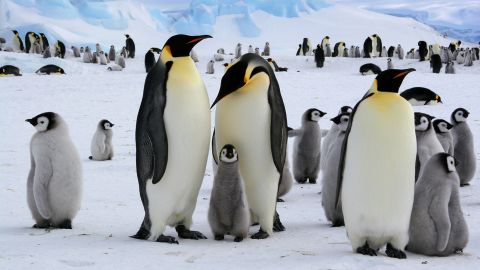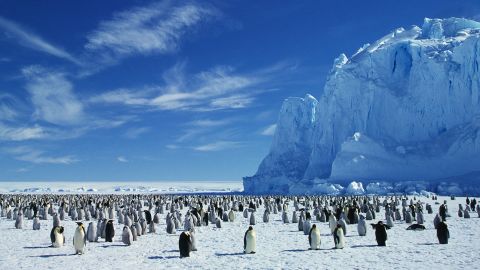
As Antarctica’s emperor penguins are increasingly threatened by the climate crisis, the flightless seabirds will receive new protections under the Endangered Species Act, or ESA.
With global warming melting the sea ice the penguins depend on for their survival, the US Fish and Wildlife Service now categorizes the species as threatened. The federal agency lists “imperiled species as endangered or threatened regardless of their country of origin.”
The Tuesday announcement came more than a year after an initial proposal by the service to protect emperor penguins under the ESA.
Emperor penguins rely on sea ice to form their breeding colonies, avoid predators in the ocean and forage for food. But as Earth’s temperature rises in relation to greenhouse gas and carbon dioxide emissions, sea ice is at risk of disappearing.

When sea ice melts or breaks apart earlier in the season than expected due to global warming, entire penguin colonies can decline or disappear.
“This listing reflects the growing extinction crisis and highlights the importance of the ESA and efforts to conserve species before population declines become irreversible,” said Martha Williams, US Fish and Wildlife Service director, in a statement.
Parts of the Antarctic Peninsula’s sea ice have melted by more than 60% in 30 years, according to the Woods Hole Oceanographic Institution in Massachusetts. And if emperor penguins suffer and decline, it’s likely that other species within the ecosystem are also at risk due to the climate crisis. Emperor penguins forage for krill, fish and squid in the sea, but they also serve as prey for leopard seals and killer whales.
“Climate change is having a profound impact on species around the world and addressing it is a priority for the (Biden) Administration. The listing of the emperor penguin serves as an alarm bell but also a call to action,” Williams said.
There are about 61 emperor penguin breeding colonies along Antarctica’s coastline, which in total consist of between 270,000 to 280,000 breeding pairs (or 625,000 and 650,000 individual penguins, including juveniles), according to the US Fish and Wildlife Service. The bird population is currently stable, but research has suggested that the emperor penguin’s population will decrease by 26% to 47% by 2050, or drop to 185,000 or 132,500 breeding pairs, according to the service.
Emperor penguins are the tallest and heaviest of the 18 penguin species. They can weigh up to 88 pounds (40 kilograms) and stand 45 inches (1.1 meters) tall. A female emperor lays one egg per breeding season, then passes it over to her male partner to incubate while she forages for food for about a two-month period.
Once the female bird returns, she shares parenting duties with her partner until their chick leaves the colony about 150 days after birth. The chick is then able to look after itself and set out for open water to forage. But first, the chick must shed its down before growing the waterproof feathers it uses to swim — if it’s still covered in down when the ice breaks, it’ll sink and drown.
Protecting penguins
Listing the species as threatened now could help save emperor penguins from becoming endangered or extinct in the future.

The Endangered Species Act is “the world’s strongest environmental law focused on preventing extinction and facilitating recovery of imperiled species,” according to the Woods Hole Oceanographic Institution. The polar bear was the first species listed as threatened due to climate change under the Endangered Species Act in 2008. Since then, many of the world’s polar bear populations have stabilized, but they remain vulnerable as the climate crisis continues.
The listing can help establish strategies to increase the resilience of threatened species and reduce threats to their existence. For emperor penguins, this means international cooperation on conservation practices, increased funding for conservation efforts and likely more research into the species.
“Listing emperor penguins as a threatened species is an important step for raising awareness about the impact of climate change,” said Stephanie Jenouvrier, associate scientist and seabird ecologist at Woods Hole Oceanographic Institution, in a statement.
“Emperor penguins, like many species on earth, face a very uncertain future, which is dependent on people working together to reduce carbon pollution. We should draw inspiration from the penguins themselves; only together can penguins brave the harshest climate on Earth, and only together can we face a difficult climate future.”
A sentinel species
Emperor penguins are an ideal species to study in a fluctuating ecosystem because their population numbers and behavior can indicate if something is wrong. By studying the birds, Dan Zitterbart, an associate scientist at Woods Hole Oceanographic Institution, and his team can learn about the impacts of the climate crisis in Antarctica.
“Emperor penguins are a sentinel species that highlight the vulnerability of ice-dependent species in a rapidly warming world,” said Zitterbart. “Although they live far from human activity, the far-reaching effects of climate change present the most substantial threat facing the species’ survival.”
Since 2017, Zitterbart and other researchers have been tagging 300 penguin chicks per year with a system similar to the way dogs and cats are microchipped. The initiative is part of the MARE project, which aims to measure the health of the Antarctic marine ecosystems through long-term monitoring of emperor penguin populations over the next 30 years.
By tracking and studying penguin behavior, researchers can observe how the animals adapt as their environment shifts due to the climate crisis. Microchipping the penguins allows the team to determine where the penguins go when they dive off the sea ice into the ocean and understand their foraging strategies. This insight can help determine the size of marine protected areas.
If greenhouse gas emissions continue to rise at their current rates, leading to warming temperatures and melting Antarctic sea ice, 98% of the emperor penguin population could all but disappear by 2100, according to a study published last year in the journal Global Change Biology.
“The world needs to take aggressive actions to reduce greenhouse gas emissions now, and the Paris Climate Agreement objectives must be met, to help prevent further population declines,” Jenouvrier said.




